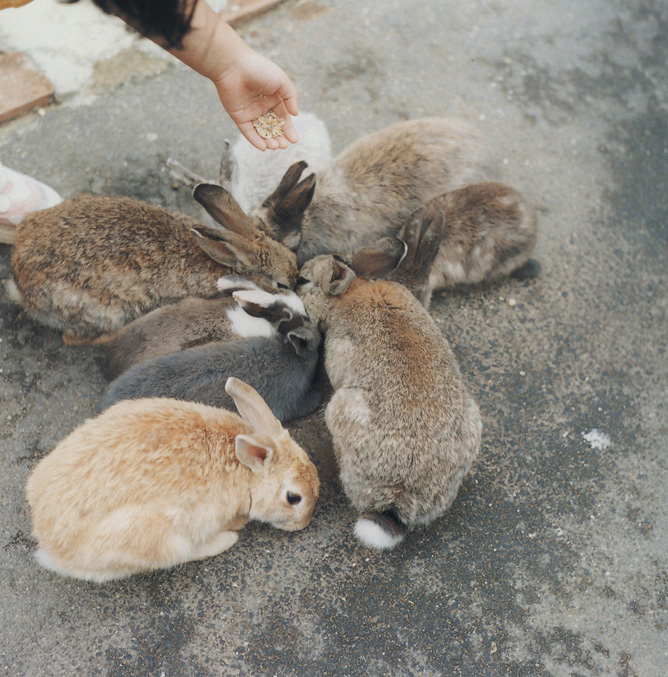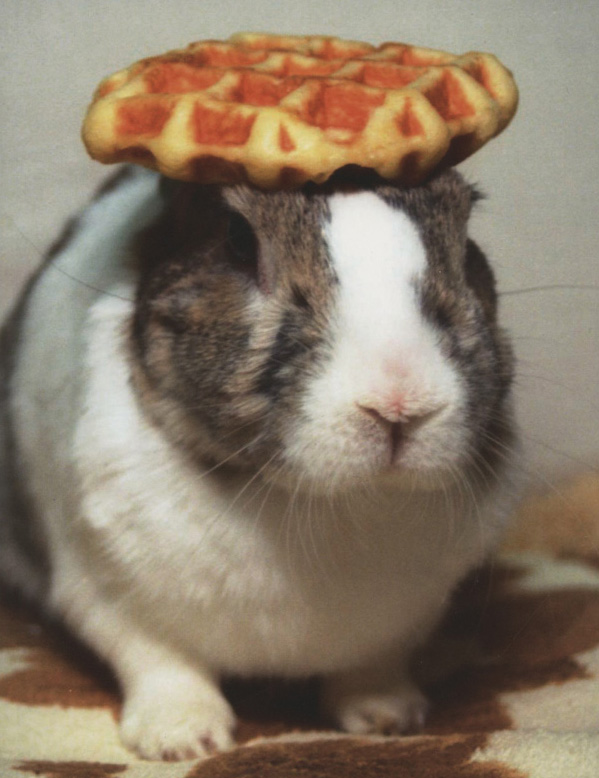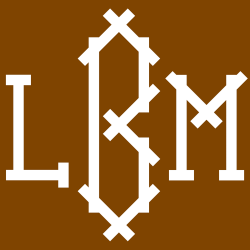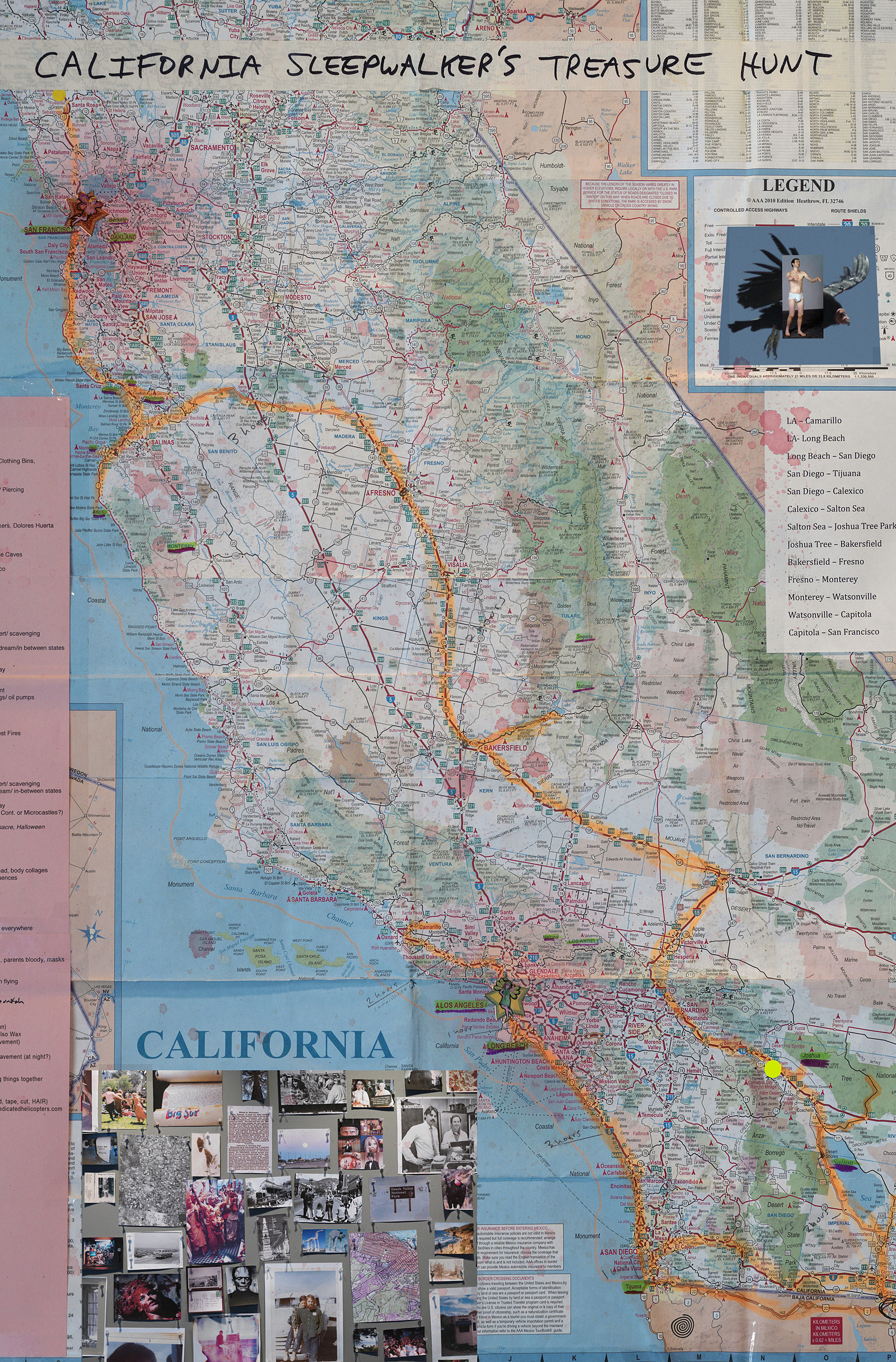Just in time for spring, the Walker Art Center presents its first Local Artist T-Shirt Mart from 11 am–5 pm Saturday, April 17, in Cargill Lounge. The latest t-shirt designs for adults and children by locally based artists ranging from design collective Burlesque of North America to Little Brown Mushroom books will be on sale. Proceeds from all sales support the Walker’s artistic and educational programs. This event is part of MNFashion Week, April 16–25, 2010. For more information: www.mnfashionweek.com.
Alec Soth/LBM needs your help
I’m headed out West next week for a project entitled ‘The California Sleepwalker’s Treasure Hunt.‘ I have a whole bunch of stuff I’m trying to track down and could use some help. If your tip leads to a picture, you’ll receive a reward. I’m looking for specific leads you might have in California (see my route on the map below) for the following:
-Condors
-Sleepwalkers (specific individuals would be best)
-Punk hangouts
-Self-mutilation/flagellation, scarring
-Horror film (in progress….otherwise horror makeup artist)
-Star Wars iconography / Star Wars collectors
-Dolores Huerta / United Farmworkers
-Bats
-Hare Krishnas
-Metal detector enthusiasts
-Hang Gliders
-Frankenstein
-Emo’s in Tijuana or Mexicali
-anything else that fits this stream of thinking
Please leave your tips in the comments section.
Many thanks,
![]()
Daylight Magazine | Center for Documentary Studies Photo Awards
![]()
Guest jurors include:
VINCE ALETTI, writer/critic, the New Yorker magazine;
DARIUS HIMES, editor/curator, Radius Books;
JULIE SAUL, gallery owner/director, Julie Saul Gallery;
ALEC SOTH, photographer;
HANK WILLIS THOMAS, photographer;
JAMIE WELLFORD, international photo editor, Newsweek magazine
Direct link to submit work here
Link to information / overview / contest and award details here
Online submissions accepted March 15 – May 15, 2010.
Alec Soth: New York Times Blog
My first post as a New York Times contributor is up. Have a look here. If you feel compelled, I’d be ever so grateful if you’d leave a comment on the Times site. Many thanks,
![]()
First Book: Bill Hunt
I have been going around to photographers asking them one question: “What was the first photo book that you can remember buying or seeing that really had a strong affect on you?”
Alec was able to ask the gallerist Bill Hunt the same question. Here is Bill’s response:
‘I am a reflection photographing other reflections within a reflection. To photograph reality is to photograph nothing.’
The first book I remember caring about is Duane Michals “Real Dreams” (Addison House 1976). It is still magical. The sequences have a theatrical and spiritual center. I must have gone through a couple of dozen copies because I kept giving them to friends. It seemed to communicate in a way that I felt but couldn’t articulate myself.
When I met Duane I actually bent down and kissed the hem of his pants, an act that took both of us considerably by surprise. It did make an impression. He is truly a master of many things, and we have some history together.
He did a very a special holiday card to benefit Photographers + Friends Against AIDS (“Merry Christ Mouse” leaving what seemed to be a very questionable – vaguely scatological – gift near the Christmas tree). I can be a fairly emphatic and direct speaker, but was totally left in Duane’s wake at a speaking engagement with him at the Savannah College of Art and Design where he dramatically and hysterically insisted that the students take themselves and their careers seriously and not settle into any sort of complacency. Recently he came to my gallery to look at Paolo Ventura’s “Winter Stories”, and it struck me as the most powerful endorsement a contemporary artist working with fantasy could receive. Further Duane bought a piece and said it was the first photograph he had ever purchased.
I love Duane. So much of my considerable passion for photography can be traced back to “Real Dreams” and his unparalleled ability to take you into his imagination.
A further note, I think that I bought all those copies of “Real Dreams” at A Photographer’s Place, the late lamented bookstore on Mercer St. owned by Harvey Zucker. Anyone over a certain age truly cut their teeth on books in that store. You could spend hours in there browsing and buying. He and the staff were wellsprings of information about photographers and books. Also you always ran into or got introduced to people there. It was a real hangout. Amazon does not provide nearly the same experience.
And that’s the story of my first photo book.
WM Hunt
HASTEDHUNTKRAEUTLER
![]()
Triumphs of contemporary marketing.
The Bunny Book Coincidence
I’m currently in Brighton, England with my family (and thus the lack of posts lately). I was supposed to be here working on a commission for the Brighton Photo Biennial, but due to some visa problems, I’m not allowed to work. So the trip is pretty much an Easter vacation. But my kids and I have been collaborating on some book projects. On the very day that Carrie posted about rabbit books, my daughter and I were putting the finishing touches on our book, “The Brighton Bunny Boy.” For contractual reasons (with my daughter), I’m not allowed to show the whole thing, but here is a sneak peek:
Be sure to check out Carmen’s last book, The Mountain Trip.
![]()
Rabbit Books
When I was young my mother collected antiques. She specialized in antique rabbit items. She had rabbit chocolate molds, rabbit furniture for children, stuffed rabbit toys, but my favorite was a little book named: Four Little Bunnies.

While I was in Japan I met a rabbit named Goma. I am now obsessed with rabbits and photographers who make books and photographs about rabbits.

This is a beautiful rabbit photo by Rinko Kawauchi

And this is the new In Almost Every Picture 8. Its the story of Oolong a Japanese rabbit.
Does anyone know of any other good photography books about rabbits?
Latin American photobook competition
Editorial RM has announced the first edition of their competition for The Best Photobook 2010 of Latin America. Registration is free and the limit for submissions is July 30th, 2010. The jurors are Martin Parr, Lesley Martin, Álvaro Sotillo, Diran Sirinian, Ramón Reverté, Alexis Fabri and Juan Pablo Queiroz.
Editorial RM will publish and promote the winning book.
More information here
![]()
First Book: Todd Hido
I have been going around to photographers asking them one question: “What was the first photo book that you can remember buying or seeing that really had a strong affect on you?” Here is Todd Hido’s response:
I remember it clearly. It was 1986, my first year of college. A teacher of mine showed us Emmet Gowin’s Photographs. It spoke to me in a 1000 different ways. I saw the image where he has the curtains tied open to the hanging light in the center of the room. Edith awaits, leaning on the bed. Completely surreal. You know instantly things are not exactly as they appear to be—that there is some force of quiet strangeness taking over. It feels almost sinister. After meeting Emmet years later, I bet that darkness was not what he saw. But that was just it—that is what I saw.
From that day I realized that you can take simple, ordinary, everyday things and make something out of them. You can make a statement by using what is right in front of you. It was a powerful lesson that stayed with me: you can use your room, your home, your neighborhood, your family to make art. (This point was further reinforced for me by seeing a show called The Pleasures & Terrors of Domestic Comfort at MOMA in New York, and ultimately by becoming a student and friend of Larry Sultan’s, who drove that lesson all the way home for me…)
Gowin’s Photographs also taught me how powerful a heavy dose of emotion can be—his work is so tender and sincere. The story of this book continued as my path blindly lead me to the Museum School in Boston. It turned out that one of my favorite teachers ever, Virginia Behan, was a neighbor of Gowin’s. Also, another one of my great teachers, Jim Dow, had been classmates with Emmet at RISD. Dow, Behan, and a third professor of mine, Elaine O’Neil, invited him to visit our school many times. Here I was meeting the person whose work had affected me so much! It really was very lucky for that to happen.
Over my years at the Museum School there were several encounters with Emmet. He was so open and shared so much of his process with us. I remember one day he had us over to his home and we got to see where he made his prints. It was a darkroom made in an extra room of his home. It was so simple. Nothing fancy. Seeing these things, these small things like where one of the best printers in the history of the medium did his thing—with a set-up that wasn’t really all that special—was invaluable. It demystifies the process; it makes you think, “hey—this is not unattainable—maybe I could do this too?”
Todd Hido

![T-SHIRTMART[1]](http://littlebrownmushroom.files.wordpress.com/2010/04/t-shirtmart1.jpg?w=1023)






